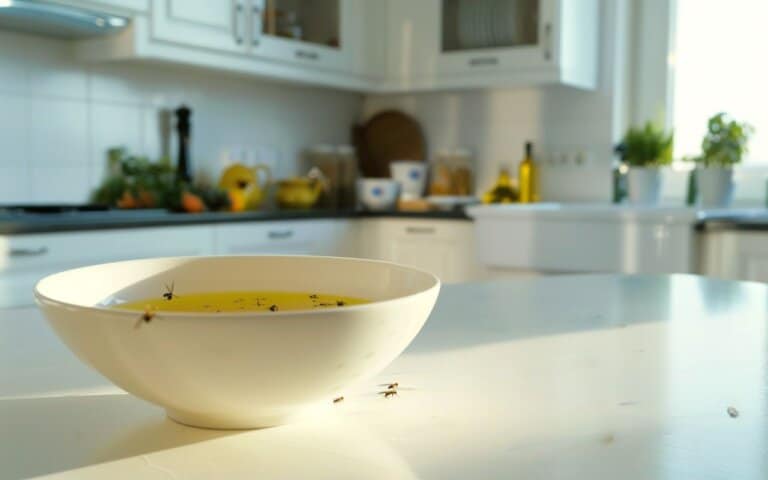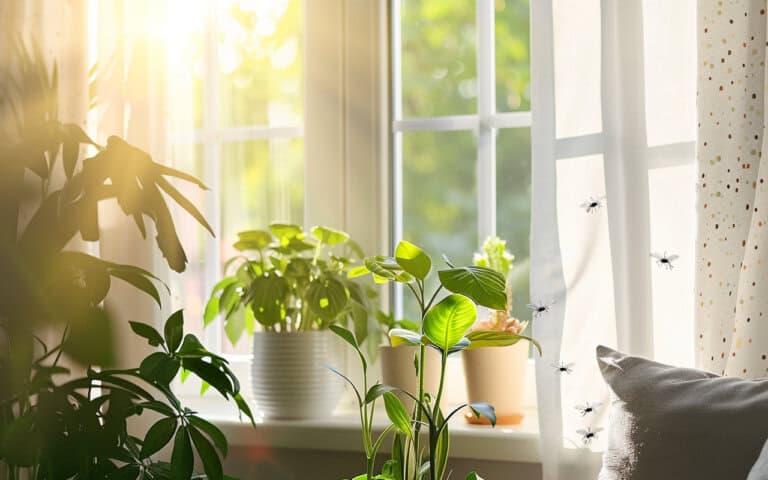On thing I hate about the hot weather are those pesky little gnats that fly around in my house.

Gnats are small insects that look a lot like fruit flies, but they’re different.
Gnats are usually attracted to moisture and decay, while fruit flies prefer, well, fruit (and veggies, too!).
Either way, they are annoying, and once they’re in full swing, getting rid of them can seem like a challenge.
No matter what I do, they just show up again and in different places in my home like…my bathroom!
Well, fortunately my MIL saved me from this gnat house problem.
So, if you are fed up with this and want to know how to get rid of gnats in the house – and I’ll let you know which one is the easiest.
Let’s get started!
Where Do You Find Gnats?

Gnats can show up anywhere in your home, but mostly, you’ll find them in your kitchen or around your houseplants.
Again, they’re drawn to moisture and organic materials, so things like damp areas and overripe fruit give them prime breeding grounds.
Preventing Infestations
The first step in dealing with gnats is to keep them from showing up in the first place! Here are some tips to help you ward off these annoying pests before they become a problem:
What Causes Infestations?
Okay, let’s talk a little more in-depth about what causes infestations in the first place. Common causes of gnat infestations include:
- Moisture: Gnats are attracted to moist environments, making areas with standing water or high humidity levels prime breeding grounds. Leaky pipes, dripping faucets, and waterlogged soil in potted plants can all attract gnats.
- Organic Matter: Gnats feed on decaying organic stuff, like overripe fruits, vegetables, and compost. Organic debris in garbage bins, drains, and indoor compost bins can attract gnats and provide them with a food source.
- Warm Temperatures: Gnats thrive in warm temperatures, especially during the spring and summer months when conditions are favorable for breeding. Warmer indoor environments can speed up their life cycle, leading to rapid population growth.
If you can keep these types of environments from forming in your home, you have a better chance of keeping gnats away!
Keep the House Clean
Keeping your house clean can help prevent gnat infestations. Here are some tips to help you keep your home gnat-free:
- Clean Regularly: Create a routine cleaning schedule to keep your home free of debris and spills that could attract gnats (you can find some weekly cleaning schedules here!). Wipe down surfaces and clean your floors to remove crumbs and food particles that may serve as gnat food sources.
- Empty Trash Cans: Get rid of household waste right away, and make sure your trash cans are emptied regularly. Use sealed trash bags to prevent odors and reduce the risk of attracting gnats to garbage bins.
- Clean Drains: Keep kitchen and bathroom drains clean and free of buildup to prevent gnats from breeding in standing water. Mix baking soda and vinegar in the drain, or use a commercial drain cleaner to clear clogs and leftover organic matter.
Proper Food Storage
Remove temptation by storing your food properly, especially when it comes to fruits and vegetables:
- Seal Containers: Keep fruits, vegetables, and other perishable items in sealed containers or resealable bags to prevent gnats from getting to them. Air-tight containers help preserve food freshness and deter gnats from laying eggs on exposed surfaces.
- Refrigerate Perishables: Refrigerate ripe fruits and vegetables to help them last longer and reduce the risk of attracting gnats. Cold temperatures stop gnats in their tracks and prevent fruits from fermenting, making them less appealing to these pests.
- Clean Food Preparation Areas: Wipe down countertops, tables, and cutting boards after preparing food to remove any spills or residues that could attract gnats. Rinse fruits and vegetables thoroughly before storing them to remove any lingering odors or residues that may attract pests.
Seal Entry Points
Gnats can get into your home through tiny openings and cracks in walls, windows, doors, and plumbing fixtures.
Here are some ways you can seal their entry points and keep them out:
- Inspect for Gaps: Take a look around your home to find any potential entry points for gnats. Check for gaps around window frames, door thresholds, electrical outlets, and pipes.
- Seal Cracks and Holes: Seal any cracks, gaps, or holes found during your inspection with caulk or weatherstripping. Pay attention to areas where pipes or wires enter your home, as these are common entry points for pests.
- Install Screens: Make sure that your windows, doors, and vents have tight-fitting screens to prevent gnats from flying indoors. Repair or replace damaged screens to keep pests out.
Natural Remedies for Gnat Control

Even though an ounce of prevention is worth a pound of cure, sometimes you just can’t keep gnats out of your house 100%.
If that’s the case, it’s time to call in the remedies! Here are some natural remedies for gnats you can try if you want to stay away from chemicals:
Essential Oils
Essential oils not only smell nice, but they can also act as natural insect repellants. Certain oils, like peppermint, lavender, and eucalyptus, contain compounds that will keep gnats (and other insects) away!
Mix a few drops of essential oil in water in a spray bottle. Mist the solution around areas where gnats are hanging out, like your kitchen and windowsills.
I love this natural solution because you can use it to get rid of gnats in house plants without hurting your leafy friends!
To make sure the gnats are gone for good, keep spraying as needed.
Vinegar Traps
When you have a gnat problem, vinegar traps are another super easy solution.
Gnats are naturally attracted to the sweet scent of vinegar, so you can use it as bait. To make a trap:
- Fill a small bowl or cup with apple cider vinegar.
- Add a few drops of liquid dish soap.
- Cover with plastic food wrap and poke a few small holes.
The dish soap breaks the surface tension of the vinegar, causing the gnats to sink and drown when they touch it. Poking the holes in the plastic wrap just helps any stragglers from escaping.
Put these traps wherever the gnats are most active, like near your fruit bowls or houseplants. Empty and replace the traps once they get full to make sure they keep working!
Plant-Based Solutions
If you want some ideas that don’t require a lot of work, just get some gnat-repelling plants for your home!
Not only will these plants look and smell amazing, but they’ll repel gnats and other flying pests.
Plants like basil, lavender, and citronella have natural odors and oils that can help keep pesky insects away.
Just keep in mind that these plants may not help if you are already dealing with an infestation, but they will encourage a gnat or two to leave.
Chemical-Free Gnat Control

If the natural remedies aren’t cutting, there are still some chemical-free options you can try:
Diatomaceous Earth
Diatomaceous earth is a natural rock powder that is harmless to humans and pets—but it is lethal to insects like gnats!
When sprinkled on the soil of houseplants or around infested areas, diatomaceous earth absorbs the waxy outer layer of the gnats’ exoskeletons, ultimately leading to their demise.
One of the advantages of diatomaceous earth it lasts long and stays active as long as it’s dry. However, if you use it in your house plants, you’ll have to reapply it after watering.
To use diatomaceous earth, simply sprinkle a thin layer on the surface of the soil in your houseplants or directly onto areas where gnats are present.
Be sure to wear a mask to avoid inhaling the fine particles, and keep pets away from treated areas until the powder has settled!
Sticky Traps
Sticky traps are another chemical-free method for controlling gnat populations.
These traps have a non-toxic adhesive surface that lures gnats in and prevents them from escaping. They’re especially effective for capturing adult gnats and preventing them from laying eggs.
Sticky traps come in various forms, including yellow sticky cards and sticky ribbons. Once they land on the sticky surface, they become ensnared and are unable to fly away.
To use sticky traps, simply place them near areas where gnats are active, such as kitchen counters, near houseplants, or around windows.
Replace the traps regularly as they become covered with gnats or dust.
So, What’s the Easiest Way to Get Rid of Them?
The easiest way to get rid of gnats is to prevent an infestation in the first place!
But if that doesn’t work, then a combined effort is your best bet for getting rid of these pesky bugs.
Start with a sticky trap to see if you can catch the critters before they multiply and spread.
This is an easy method because you don’t have to prep anything or treat areas multiple times. Just hang up a sticky trap, and you’re good to go!
Vinegar traps are super popular and probably a good bet if you don’t feel like seeing gnat corpses hanging around your room!
Honestly, all of these gnat-elimination methods are easy, so it’s a matter of finding one that works for your home.
And, if all fails, you can always call a professional if things get out of hand.
Gnats Be Gone!
Whether you’re trying to get rid of gnats in your kitchen or all around your home, it’s not as exhausting as you may think!
With these awesome tips, I know you’ll find an easy way to get rid of those annoying flying insects and enjoy a gnat-free living space.
Just remember to stay on top of it and do what you can to prevent infestations in the future. Good luck!
Follow me on Pinterest for more cleaning hacks and home decor ideas!



